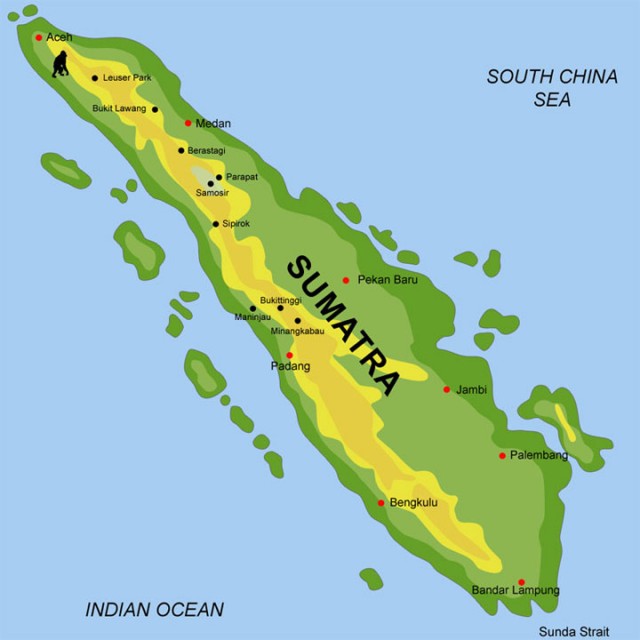Sumatra
SUMATRA IS IN Southeast Asia and is the sixthlargest island in the world. It is part of the country of INDONESIA. The island was largely under Dutch control beginning in the 17th century but joined newly independent Indonesia in 1949.
Sumatra runs northwest–southeast for about 1,060 mi (1,700 km). The island sits on the southern edge of the massive Eurasia lithospheric plate. The northeastward moving Indo-Australian plate is subducting beneath the Eurasia plate to create the Sunda ocean trench, just off the island's southern shore. The subduction of the Indo-Australian plate is responsible for the island's frequent earthquakes and volcanic eruptions. The mist-shrouded Barisan Range is a volcanic chain and the mountainous backbone of the island. Situated in the intertropical convergence zone, the climate of the island is a wet, tropical rainforest type. Sumatra's forests and swamps are home to many endangered species of mammals, including the orangutan and the Sumatran rhinoceros, tiger, and rabbit, as well as endangered birds, such as the Sumatran cochoa and ground cuckoo. The government manages several large blocks of intact forest as wildlife preserves, but illegal logging and poaching threaten the great diversity of life in these areas.

Sumatra sits astride important seafaring trading routes, so that historically, it has been a crossroads of cultural influences from the MIDDLE EAST, INDIA, CHINA, and elsewhere in Asia. Dutch colonial rule (1824 to 1949) is the most notable period of European impact. About 46 million people live in Sumatra, but the island's population density is relatively low because of its large size. The main urban centers are Medan (2.5 million people) and Palembang (1.5 million people). The people are of Malay stock. They speak 52 different languages, but they are closely related and the people share the religion of ISLAM. The three main ethnolinguistic groups are Acehnese (3.4 million), Batak (3 million), and Minangkabau (3.5 million). The Acehnese have a tradition of militancy and resistance to outside control. An armed insurgency has been active in ACEH in recent decades. The Batak dominate in the highland interior of Sumatra Utara Province. The Minangkabau dominate along the coasts of Sumatra Utara and Sumatra Barat and other scattered areas. Ethnic Chinese and Indian merchants also have an important presence in urban centers.
The island's economy is underdeveloped. The Barisan Range contains small deposits of coal and gold. The fertile soils of mountain basins, such as Lake Toba basin, are a basis for coffee exports. Batak hill people export textiles from the highlands. The lowlands export palm oil. The shallow waters along the east coast are productive fisheries. The northern end of the island possesses one of Indonesia's largest reserves of petroleum oil and natural gas. Multinational corporations such as ExxonMobil have drilling operations there.
Sumatra took a direct hit from the TSUNAMIS generated by a major earthquake that took place in the INDIAN OCEAN on December 26, 2004. Including the Aceh territory on Sumatra, the island suffered some 100,000 casualties from the destructive waves.